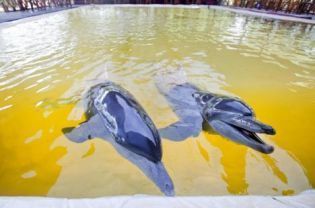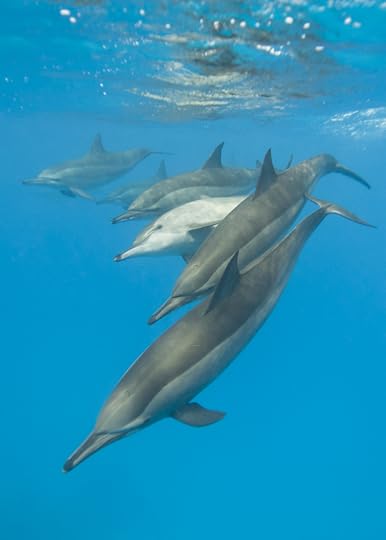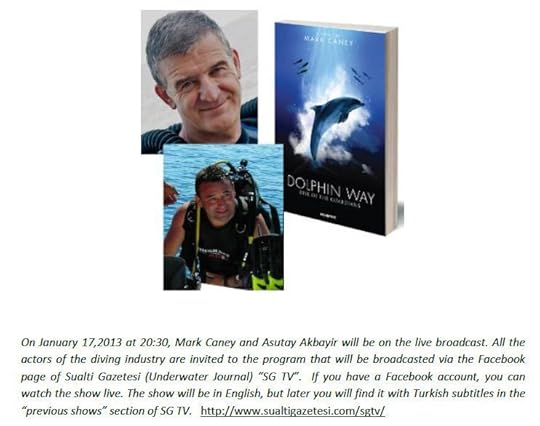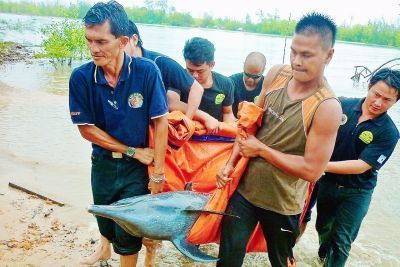Mark Caney's Blog, page 38
February 7, 2013
Circus Mob Threatens Dolphin Activists
 A discussion in Jakarta on Wednesday featuring the star of an Academy Award-winning documentary on dolphins was marred by a mob questioning the legality of the gathering and threatening to break it up.
A discussion in Jakarta on Wednesday featuring the star of an Academy Award-winning documentary on dolphins was marred by a mob questioning the legality of the gathering and threatening to break it up.
The discussion, hosted by the US Embassy at the @america cultural center in the Pacific Place mall, was held to address the controversy of traveling circuses in Indonesia that have dolphin shows.
Richard O’Barry, the renowned US dolphin activist and star of the 2009 documentary “The Cove,” attended the event wearing a bulletproof vest, amid concerns about threats as a result of his activism in the Indonesian circus controversy.
Outside the venue, visitors were heckled by a mob of men dressed in black uniforms, who claimed that the organizers did not have a permit to hold the discussion. The mob, calling itself the Indonesian Alliance, also disrupted the discussion and claimed to represent one of the circuses.
“All we got was intimidation and harassment from these circuses,” O’Barry said, as quoted by Tribunnews.com.
“Some of them are outside this room right now! They threatened JAAN [Jakarta Animal Aid Network] members.”
Femke den Haas, an activist from the JAAN, added, “We just want to protect dolphins but we have to wear bulletproof vests? That’s ridiculous!”
The discussion itself was opened by Zulkifli Hasan, the forestry minister, who insisted that no traveling circus in Indonesia was permitted to transport live dolphins. He called on activist groups like the JAAN to help officials deal with the problem. O’Barry said that was what he and the JAAN had been doing since last year.
The minister also deflected a question from an audience member who said he had seen a dolphin performance at a circus in Bantul, Yogyakarta, and been told by the circus officials that they had obtained their permit from the Forestry Ministry.
“You just tell me where this circus is, and if needs be, I’ll go there myself and break it up,” Zulkifli responded.
He left the event shortly after, citing another engagement.
The controversy erupted last July after the JAAN launched a petition to urge companies that provided transportation service or venues for the circuses to end their support, in light of the dire conditions in which the dolphins were kept.
The online petition, at change.org/stopsirkuslumba, has garnered more than 90,000 signatures to date.
Source: Jakarta Globe

February 3, 2013
Mass stranding of common dolphins on Achill Island, Ireland
Over the last two days at least eight common dolphinsDelphinus delphis have been found dead on the beaches of Achill Island, Co. Mayo. Unconfirmed reports suggest that there is another dead dolphin on a nearby island and another may have been buried on the beach.
IWDG don’t have full details to hand as yet but photos sent to us by local people show most of the dolphins died very recently although there are no reports of any live strandings there over the last few days. So far, dead common dolphins are confirmed at Keel Beach, Keem Beach and Dookinella. While there are occasionally live strandings involving groups of dolphins, it is very unusual in this country to see this number of dead dolphins washed ashore over a 10km area. Updates will be added here as and when we have further information.
Source: IWDG

February 1, 2013
Were 900 dolphins murdered out of spite?
As many as 900 dolphins have been slaughtered by villagers in the Solomon Islands, allegedly due to a dispute with the conservation group Earth Island Institute.
Accounts from the Islanders suggest the villagers were expecting payment from the conservation group to stop their traditional hunt. The check never arrived, resulting in a hunt more fervid than usual. The Earth Island Institute alleges the slaughter was the work of a “renegade group,” according to U.K. newspaper The Guardian.
According to Radio Australia, villagers from Fanalei, on the island of Malaita, had been in negotiations with the California-based conservation group for two years. They accused the Earth Island Institute of failing to pay the agreed upon $400,000 to halt their traditional hunt. Villagers claim they received only one third of the promised payment before funds dried up.
As a result, the disillusioned villagers went back to hunting, according to Fanalei community leader Atkin Fakaia.
The Solomon Islands are well known as a hot bed for dolphin hunting. The Islands supply wildlife to aquariums in China and Dubai, where a live dolphin can go for upwards of $150,000. Earth Island Institute hoped to preserve the dolphin population by offering restitution for not hunting.
“We are very, very disappointed,” David Phillips, who oversees international dolphin protection efforts for the conservation group, told The Guardian. “This is a tragedy. It’s bad for dolphins. It’s bad for the community. It’s bad for the Solomon Islands as a nation to have this blot on the record.”
Source: CBS News

January 28, 2013
Dolphins try to save dying companion
 Common dolphins have been seen gathering to aid a dying companion, trying to support it in the water and help it breathe.
Common dolphins have been seen gathering to aid a dying companion, trying to support it in the water and help it breathe.
This is the first time that a group of dolphins has been recorded trying to help or save another dying dolphin.
Korean-based scientists witnessed the event in the East Sea off the coast of Ulsan, in South Korea.
Five individual dolphins formed a raft with their bodies in an attempt to keep the stricken dolphin afloat.
Details of the behaviour are reported in the journal Marine Mammal Science.
Healthy cetaceans, the group of animals that includes whales and dolphins, have been seen attempting to provide supportive care to individuals before.
For example, in the mid-20th Century, a bottlenose dolphin (Tursiops truncatus) in captivity was seen lifting her stillborn calf to the surface with her back.
Wild bottlenose dolphins have also been seen supporting dead or stillborn calves near the surface, while some have been recorded stimulating their babies by biting them.
But all previous examples involved just one or two adult dolphins trying to rescue a calf.
Now Kyum J Park of the Cetacean Research Institute in Ulsan, Korea, and colleagues report an incident when up to 10 long-beaked common dolphins (Delphinus capensis) tried to save the life of another adult.
The researchers routinely monitor cetaceans off the South Korean coast.
During one survey, they encountered a group of long-beaked common dolphins containing more that 400 individuals being followed by approximately 500 streaked shearwaters.
Both dolphins and birds were foraging, and the research vessel approached and observed the pod several times.
A small group of dolphins had separated from the pod and were splashing near to the boat.
Closer observation revealed at least 12 individuals swimming very slowly.
Among them, one dolphin was wriggling about, its body leaning over, with its abdomen showing to the surface.
Though it could move and splash its tail, its flippers appeared to be paralysed and it had red marks on its belly.
A number of dolphins circled this group, while those within appeared to be trying to help the stricken dolphin maintain its balance, by pushing it from the side and below.
Then the 10 remaining dolphins took turns to form a raft using their bodies.
Five dolphins at a time lined up horizontally into a raft-like formation, maintaining it while the stricken dolphin moved on top and rode on their backs.
One of the dolphins in the raft even flipped over its body to better support the ailing dolphin above, while another used its beak to try to keep the dying dolphin’s head up.
A few minutes later the stricken dolphin appeared to die, its body hanging vertically in the water, with its head above the surface. It wasn’t breathing.
Five of its associates continued to interact with the dead dolphin’s body, rubbing and touching it, or swimming underneath, releasing bubbles onto it.
They carried on this way despite the dead dolphin’s body showing signs of rigor mortis, say the researchers.
Source: BBC Nature by Matt Walker

January 23, 2013
Dolphin ‘asked diver for help’
A dolphin tangled in fishing line sought help from a diver in the waters of Hawaii.
The amazing encounter on January 11 was captured on video and the diver, Keller Laros, spent the better part of eight minutes tending to the needy mammal who readily accepted the help.
Mr Laros was leading a group of snorkelers for a manta ray dive experience off the Big Island’s Kona International Airport when the dolphin squealed out.
The diver explained, ‘The way he came right up and pushed himself into me there was no question this dolphin was there for help.’
The group were enjoying the aquatic sights when suddenly they heard a dolphin cry and the bottlenose dolphin swam in their direction.
Mr Laros told KITV how he soon noticed that the dolphin’s movements were inhibited because it was entangled in fishing line and a hook was lodged in its pectoral fin.
The mammal allowed the human to work to help the dolphin break free.
‘I was trying to unwrap it, I got the line fishing hook out of the pectoral fin. There was a line coming out of his mouth. But, the line wrapped around his pectoral fin was so tight and he had cuts both front and aft,’ said Laros.
‘I was worried if I tugged on it, it might hurt him more. I was able to cut the fishing line and unwrap it.’
The diver said that the animal patiently and calmly allowed him to work to remove the fishing line.
‘I’ve had bottlenose dolphins approach me a lot of times and they are really smart animals,’ Laros, a professional scuba instructor and Manta Ray researcher, explained.
Mr Laros did remove the fishing hook and clipped the line that was near the mouth but as other divers joined Laros and tried to remove more fishing line, the mammal swam off and did not return.
Source: Mail Online

January 17, 2013
Mark Caney interviewed today for Turkish live magazine show
Tonight, Asutay Akbayir is interviewing Mark Caney in a live broadcast at 1830 GMT/2030 Turkish time. It’s for the Turkish magazine Sualti Gazetesi (Underwater Magazine) and will be mostly conducted in English. Anyone can tune in through Facebook:


January 16, 2013
Mysterious dolphin deaths continue in Gulf of Mexico
An unusually high number of dolphin deaths that began three years ago in the northern Gulf of Mexico is continuing though the number of deaths in Florida, USA peaked in 2011.
From February 2010 to Sunday, the bodies of 830 marine mammals, nearly all bottlenose dolphins and a few whales, have been found along the coast from Louisiana to Apalachicola, Fla., according to figures from the National Oceanic and Atmospheric Administration.
Of those, almost 150 dolphins found dead on beaches or in marshes were premature, stillborn or neonatal bottlenose.
In the seven years before 2010, the northern Gulf each year saw an average 63 bottlenose dolphin strandings, incidents where injured or sick marine mammals come ashore.
That the number of dolphin deaths continues to be higher than before 2010 worries Teri Rowles, who heads NOAA’s investigation team.
“This is the longest unusual mortality event nationally,” she said of the dolphin deaths.
The dolphin deaths began their climb before the Deepwater Horizon disaster April 20, 2010, but the oil spill is being considered as a cause. Bacteria and biotoxins, such as red tide, also are being investigated as factors contributing to the deaths.
Scientists don’t know the full scope of the die-off because they rely on field reports of deaths. Not all dead dolphins wash up on populated beaches and waterways where they can be recovered, so many deaths may be going uncounted.
Full story: USA Today

January 10, 2013
Orcas trapped in the ice in Canada
A pod of killer whales is trapped in the ice near a northern Quebec fishing village, using only a small patch of open water to breathe, say locals in the isolated community.
In a video posted to Facebook by Clement Rousseau, a local teacher, a number of the whales can be seen taking turns breaching in the small patch of open water: some torpedo straight up, several metres out of the water, while others surface porpoise-style to catch a breath.
Simeonie Nalukturuk, public safety officer for the nearby village of Inukjuak, confirmed no less than 11 whales are trapped.
“It looks quite beautiful, but we’re not sure exactly what to do right now because where they are is very rough; the ice condition is dangerous,” Nalukturuk told CTVNews.ca by phone.
The video was recorded on Tuesday, but the whales were still there on Wednesday morning, he said.
Nalukturuk said the whales shouldn’t even be in the area this time of year. “We’ve only seen those kind of whales in the summer time, never in the winter time.”
Killer whales are not all that common in the Arctic, although there have been a gradual increase in sightings since the 1950s, and that correlates with global warming.
The hole is not much bigger than a small pick-up truck, and Inukjuak Mayor Peter Inukpuk said it appears to be shrinking in the very cold temperatures there right now. Locals have been driving from hours away to see what’s happening and help in any way they can, using chainsaws and chisels to try to open the hole for the pod.
Full story and video: CTV News

January 2, 2013
Malaysian dolphin rescued
 An injured dolphin rescued on Boxing Day in Tuaran is being nursed by experts at the Borneo Marine Research Institute (BMRI).
An injured dolphin rescued on Boxing Day in Tuaran is being nursed by experts at the Borneo Marine Research Institute (BMRI).
BMRI director Prof Dr Saleem Mustafa said the spinner dolphin weighing about 70kg was still stressed and efforts were under way to calm it as much as possible.
“I do not think the dolphin is out of danger. We do not know if it will survive despite our best efforts. All I can say is that probably it would not have survived at all had it been not been rescued.
“We can say with more certainty about its chances of survival once we see it regaining normal swimming posture, resting position and appetite,” he said.
Saleem said they would continue to monitor its health condition according to quarantine requirements. If any sign of infectious disease appears, the next course of treatment will be decided.
The seven-year-old spinner dolphin or Stenella longirostris was found along the Tuaran coast about 35km from here at about noon on Wednesday.
He said the dolphin was a bit restless from its ordeal and might have other problems which cannot be diagnosed by external observations.
“I could not see it sleeping. A healthy dolphin rests by floating at the surface, with one eye open.
“After some time, it closes one eye and opens the other one. I have not seen this alternative eye opening and closing activity. Obviously, the dolphin is restless,” he said.
Saleem said BMRI could not establish whether the dolphin belonged to the resident population in Sabah or migrated from other area.
He said the dolphin might have eaten contaminated organisms, suffered exhaustion or sickness, disorientation or injuries from being beached.
Source: The Star

January 1, 2013
Warning that Australian dolphin may become aggressive
A friendly dolphin that has been getting close to beachgoers on the NSW south coast could turn into a killer if it keeps being harassed, a wildlife rescue group warns.
The dolphin has been making regular contact with swimmers in St George’s Basin near Jervis Bay this summer.
But Janine Davis, a spokeswoman from marine rescue organisation ORCCA, said people were treating the friendly mammal like a pet and it could snap.
“Unfortunately there are some people that are not abiding the regulations and are trying to feed the animal with ham sandwiches,” she said.
“There was an incident yesterday where some parents had children with the dolphin and the children were trying to poke their fingers down its blowhole.”
Full story ABC News




